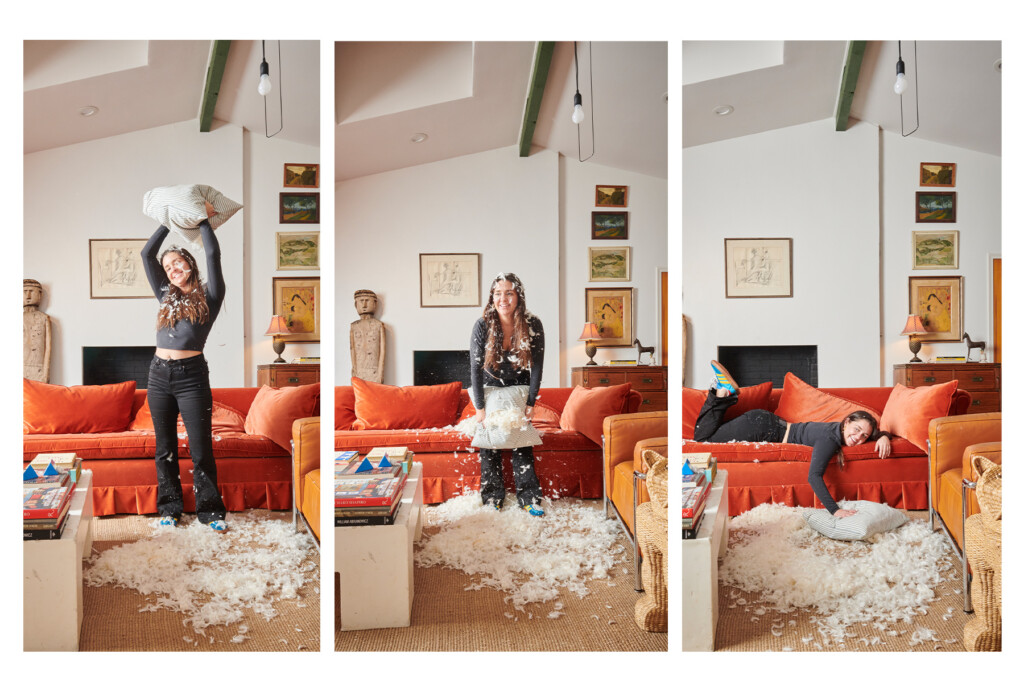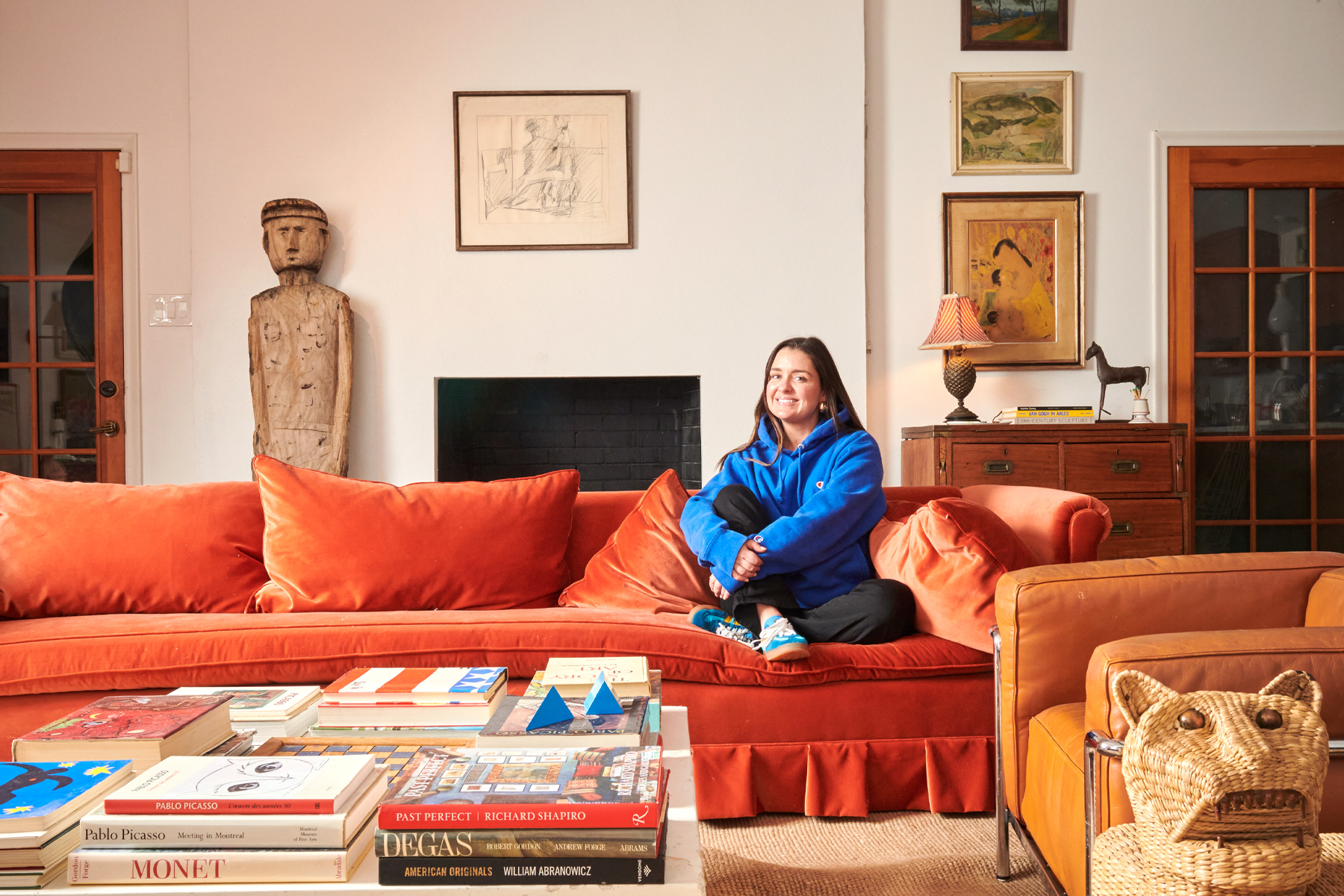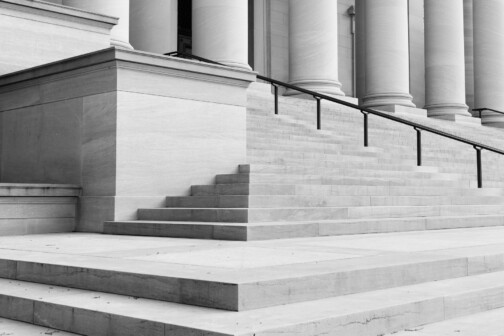There are essentially two reasons why interior stylist Kaitlyn Coffee maintains a throw pillow–free homestead. One, because she believes throw pillows are emblematic of society’s ills, specifically the mindless consumerism and unfettered capitalism that she thinks are choking our civilization to a sure and vulgar end. Also, she thinks they look dumb.
Not surprisingly, the former argument was the one that took off on social media late last summer, scoring more than 116,000 views on Coffee’s Instagram account, @HarrisVintage. In the 70-second reel, Coffee enters At Home, a Dallas-headquartered home decor and holiday superstore, and walks 10 long aisles with six shelves each, stuffed with throw pillows in a dizzying display of colors, prints, textures, and themes—everything from faux fawn fur to shag fiber to pillows stitched with amusing catchphrases such as “Allergic to Mornings.”
“This is consumerism at its worst,” Coffee says in the video. “OK, not only are the people that buy these gonna throw them out in a year because they’re out of style, but look at how much inventory this store has.” She goes on to describe the scene as “debauchery” and “complete hell.”
The comments were divided. Supporters left succinct remarks of “preach” or “Amen!” or “Society’s band aid = throw pillows.” Others stood their loose cushion ground: “I understand and agree with what you’re saying about the damage to our planet, but at the same time I couldn’t live without tons of pillows around me when I’m trying to be cozy.” Some lashed out: “So much for the sanctimonious self-important millennial.” And others took the video as a revelation: “I am so grateful to have found you. I loathe throw pillows, too! But, fell into the consumerism trap, and continued to purchase them thinking I must not have found the right one!”
This was not the first time Coffee had brought anti-throw pillow rhetoric to social media. In the summer of 2021, she posted 67 Instagram stories to her account (still viewable under the title “pillow talk”) that outline her case. In this rant, Coffee was largely focused on the aesthetic angle, sharing photos upon photos of stunning interiors sans decorative pillows, her main point being that throw pillows are a trend-riddled distraction from the art, furniture, and architecture that should take center stage. “Don’t rely on a throw pillow to express yourself,” she argued.
Not that Coffee is a minimalist. If you are one of her 57,000 Instagram followers or caught her feature on the Domino website, you know that her home is brimming with olive jars from antiques shops, funky folk-art masks found on Chairish, thrifted oil paintings, nude sketches scored at estate sales, furniture from vintage sellers on Instagram, and framed art posters off Etsy. When I visit Coffee’s ranch-style East Dallas home, she is curled up on a long sofa, which was custom-made for its original owner, to whom she paid $350 via Facebook Marketplace. She recently had the piece reupholstered in a rich orange velvet. I see not a stitch of pillow.
“Everyone’s like, do you not like comfort? Yeah, I do,” Coffee says. “But sometimes I look at these images and I’m like, where are you gonna sit? Where are your guests gonna sit? Because the pillows come out to here.” She runs her hand a few inches from the sofa seat’s edge. “I mean, don’t I look comfortable? I’m fine. I don’t need to go to sleep every time I sit on the couch.”
Coffee admits, however, that she’s having a set of king-size bed pillows covered in the same fabric as her sofa. “That’s one of the rules,” she says. “I’m always saying, like, volume two, clause five.” In truth, she has no systematic code: “I just make it up.” Aside from the pillows-matching-the-couch-color rule exception, Coffee also gives a thumbs-up to the occasional use of handcrafted plush-ware, such as a kilim or bargello needlepoint pillow. Another pass is given to maximalist interiors in which the unhinged layering of patterns and colors is the whole point.
But for the majority of us with de rigueur neutral interiors, she sees throw pillow usage as lazy design. “People are so boring about what they put in their house, decor-wise,” Coffee says. “So since there’s nothing going on there, they just throw a bunch of pattern on the couch and call it a day.” She also sees throw pillows as a Trojan horse for flash-in-the-pan fads. “Remember the ikat pillow trend? We all bought those up. And now that’s so five years ago.” How much ikat ended up in dumpsters, she wonders.
“I just feel like there’s such a fear of being different these days that everyone looks the same,” Coffee says.
Growing up, she spent weekends popping into estate sales with her dad. She remembers their first ever stop, a time-capsule house. The kitchen had bright pink-and-green floral wallpaper plus a green oven and green fridge. “I was just like, how do people not still have this stuff?” she recalls.
In 2020, when Coffee left ad agency life to take her graphic design practice freelance, she also launched an Instagram account to sell excess inventory from her continuing estate sale and thrifting adventures. There, she began posting pics of interior “inspo,” which earned her gigs curating art for Graduate Hotels and, more recently, Joanna and Chip Gaines’ new Hotel 1928 in downtown Waco. Coffee has yet to nail down a name for the style to which she gravitates.
“Artist’s houses are the main obsessive aesthetic that I love,” Coffee says. “I would say, Collected Artist’s House. It’s like everything’s very folk art, crafted, like the chair is painted and whittled.”
Don’t get her started on the craftsmanship of today’s leading home retailers. She points the finger at mass production and, worst of all, the fast-fashion superstores that rip off the midmarket chains. “It’s like dumbing it down and down and down until it’s just, literally, almost cardboard,” Coffee says. “And people will pay for it.” Because we’re snapping up poorly made, ugly, uncomfortable couches, she argues, of course we have to cover them with cushions. “There’s so many different levels to this, it’s crazy.” Coffee’s throw pillow complaints are like wild ponies, ornery and impossible to corral. “You have kids—yeah, those pillows are on the floor,” she says. Even carefully styled in high-end interiors, “I just think it looks messy.”
To gauge the temperature on wider throw pillow attitudes, I reached out to several Dallas designers. Some interior designers were not willing to speak on the record regarding throw pillows. The few willing to open up were unanimously pro-pillow.
To Barry Williams, aka “the Billionaire’s Decorator,” a throw pillow–less sofa looks “incomplete.” Decorative pillows allow him to add whimsy—color, pattern, bolsters!—into the design of an otherwise conservative estate. “Ornament has changed from heavier trims like tassels and brush trim to quieter cords, flanges, and knife edge,” Williams says. “I like them all and think they are part of a well-dressed room.”
Even the deliberate and refined interior designer Joshua Rice, a decorator who dislikes “decoration,” admits that he can’t help himself. “I always want to do no throw pillows on a sofa,” Rice says. “I try to, and it always looks empty.”
Sara See of Sees Design echoes that finishing-touch sentiment. “Custom pillows can be used like accessories or jewelry,” she says. “And they can be as loud or as neutral as the space calls for. Not to mention that pillows are functional. Someone who’s petite needs a pillow to make a deep chair or sofa more comfortable.” Mind you, See is a known “textile specialist,” though she makes a point to note, “Clearly I’m team throw pillow—but not on team fast-fashion.”
Perhaps the designer most opposed to Kaitlyn Coffee’s position is Jenn Todryk, known on Instagram as @TheRambling-Redhead. Todryk’s Insta fame (1 million followers) snagged her an HGTV show called No Demo Reno, in which she reinvents interiors without knocking down walls. On Instagram, she is often directing her followers to new deals on her favorite Amazon pillow covers or showing them how to switch out seasonal wall-art without breaking the bank.
Todryk has a closet full of throw pillows. “I’m all about making my guests feel comfortable and making a place feel cozy and warm,” she says. “And if I had furniture without pillows on it, I feel like it would be pretty stale and uneventful. And so I’m all for finding things that I can recommend to people that can give a whole different vibe, a whole different season and change a look—that doesn’t cost a ton of money. So yeah, it’s hard for me to knock throw pillows.”
But Todryk’s remarks raise an important issue: socioeconomics. To examine throw pillows from a social perspective, we’ll have to Bill and Ted our way back to the Middle Ages. It was back then, during the Ottoman Empire’s heyday, when throw pillows as we know them—the small cushy object used as a decorative element—first appear, says interior design historian Alexis Barr of the New York School of Interior Design.
Turkish interiors at that time had soaring ceilings and few furnishings. “But one thing seen quite often in these interiors,” Barr says, “are built-in sofas that are fully upholstered, sort of low and squashy and comfortable. You can imagine truly lounging on them.” These sofas were covered in loose pillows made of high-end velvet and floral fabrics, luxury goods that eventually hopped on the trade routes to Western Europe. It was in Europe, during the Age of Enlightenment, that loose cushions gained steam. “There’s this interest in the ‘art of living,’ as the French call it, and also a lot of interest in increasing personal comfort within one’s home.”
Barr thinks, specifically, of a daybed owned by Marie Antoinette on display at the Metropolitan Museum of Art, adorned with a trio of fully stuffed pillows, flanked by matching bolsters. “You can imagine sinking into that daybed and feeling enveloped in these plush, luxurious, silk fabric pillows.”
Coffee began posting pics of interior “inspo,” which earned her gigs curating art for Graduate Hotels and, more recently, Joanna and Chip Gaines’ new Hotel 1928 in downtown Waco.
It was not long before the guillotine took Antoinette’s head that the Industrial Revolution began gearing up and spitting out goods en masse—a phenomenon that not only made more products available and affordable to more people but also restructured the social order from that of a small nobility ruling a large peasantry to one with a bulging middle class.
Those in the middle could increasingly afford larger homes and the stuff that went in them. “You can fill your home with wall-to-wall carpeting, with floor-to-ceiling curtains, with upholstered suites of matching furniture,” Barr says. “Things that would have been totally beyond the reach of most people, by the middle of the 19th century, they can afford these things.” Another significant development: even common folk started using the home as self-expression.
The Victorian parlor was cluttered with tchotchkes and trinkets, with hardly a teacup-size surface area left uncovered. This everything-everywhere-all-at-once aesthetic reached its height with the concept of the “Turkish corner,” a daybed or sometimes the literal corner of the house, piled with loose pillows for the purpose of lounging, “like the way we use a beanbag chair,” Barr says.
In the 20th century, though, the wealthier class began straightening up, and by midcentury the mainstream look was clean lines and minimal decor, though there may have been practical reasons for the trend. “Some of that is a reaction to changing economics in the United States,” Barr explains. “A world with fewer servants to maintain all this stuff in your home. There’s a move to make life easier in terms of hygiene by having fewer things.”
The throw pillow fluctuations have only continued. The Laura Ashley floral decadence of the ’80s, the minimalism of the ’90s. As for the more recent trends in pillow-covered couches, Barr points to the pandemic.
“The pendulum has swung back toward wanting more in your home, especially around ideas of comfort,” she says. “This has been a tough few years for the world, and everyone is interested in the home as sanctuary. I think falling into a big comfy couch at the end of the day and having pillows to rest your head seems very appealing right now.”
After looking at throw pillows through the lens of history, I begin to see today’s plush piles as symbolic of something else: the majority’s ability to live like kings. While pillow-covered daybeds were once a luxury reserved for the Marie Antoinettes, it’s now feasible that the butcher, the baker, and the magazine maker can—on a whim, and with a few touches of a palm-size electronic device—make only a $4,000 dent in their savings to get a two-week turnaround on a gargantuan pit couch upon which the entire family can lie supine while watching Paddington 2. (For the record, I don’t regret my pit couch purchase, and, also, Paddington 2 will rip your heart out.)
Still, today’s mass-production trend cycles are a part of modern-day design history that Barr can’t ignore in her studies. “Now you have people buying IKEA or Wayfair furniture knowing that it might not last five or 10 years but being OK with that because the cycle of fast-fashion moves that quickly,” Barr says. “You can think about the impact that has, throwing out furniture every few years, how quickly a landfill is going to fill.”
According to the Environmental Protection Agency’s latest numbers, the amount of furniture and furnishings being landfilled has gone up 350 percent from 2.15 million tons in 1960 to 9.68 million in 2018. Those stats, however, are becoming increasingly important to younger consumers, says Milica Mormann, associate professor of marketing at the SMU Cox School of Business. “They not only care about the world we’ll be living in, but they also put their money—and that’s a lot of money—where their beliefs are,” she says.
Gen Z values are pushing many leading companies to transition toward more sustainable practices. Mormann refers to “takeback” programs at retail giants IKEA and H&M that allow consumers to bring in old, unwanted items in exchange for a voucher toward new merch. “It is just a question of time as to how quickly this all trickles down through various industries and small businesses who may be laggards compared to the market leaders,” Mormann says. She implies that there could be consequences for companies that don’t participate in this circular economy that makes reusing and recycling a priority.
“Importantly, there is a whole lot of business opportunity within this transition. It may be a bit of the keep up or get left behind type of thing.”
As for sustainability practices at At Home, the superstore from Coffee’s video, I’m unclear. Representatives declined a request for an interview and did not respond to specific questions about pillow sales or what the company does with excess throw pillow inventory. The company’s most recent sustainability report referred to Habitat for Humanity takeback days, but when I called my local store, the salesperson had never heard of it. The PR team did email me a written statement that reads: “We have throw pillows in all colors, sizes, and price points because everyone should have the ability to make their house a home—in their own style and taste. And if throw pillows aren’t your preference, we get it! We have everything else you need for every style, and every room.”
“It’s gotten so out of hand that it’s grotesque,” Coffee says of today’s retail landscape. “Really, it’s grotesque how much product these companies are putting out without even thinking about it.”
She believes merchandisers have made suckers out of consumers, and we have senselessly succumbed to novelty in the form of summertime lemon prints and “Ho Ho Ho” pillows. So she urges us to rewire our consumer brains when it comes to design. She gives us permission to take time filling our spaces, to thoughtfully collect, to make our homes an expression of our experiences rather than mindlessly amass. And she encourages us all to hop in the whirlpool of the circular economy. Coffee suggests checking Facebook Marketplace, vintage sellers, and thrift shops before hitting up the big-box stores. “I guarantee you’ll find something better and cheaper, and you can pick it up that day.”
Best of all, Coffee says, is investing in custom-made pieces built by local artisans. The price tag on a custom sofa may be larger upfront, but the piece will likely last for decades.
“If it is custom-made and extremely high quality, you can re-cover that bitch for 40 years if you want,” Coffee says, “and then when your kids get it, and it’s 2050, and the trend is, you know, neoprene fabric, they can re-cover it with that.” Naturally, matching neoprene pillows get a pass.
This story originally appeared in the January issue of D Magazine with the headline “Pillow Fight.” Write to [email protected].
Author









